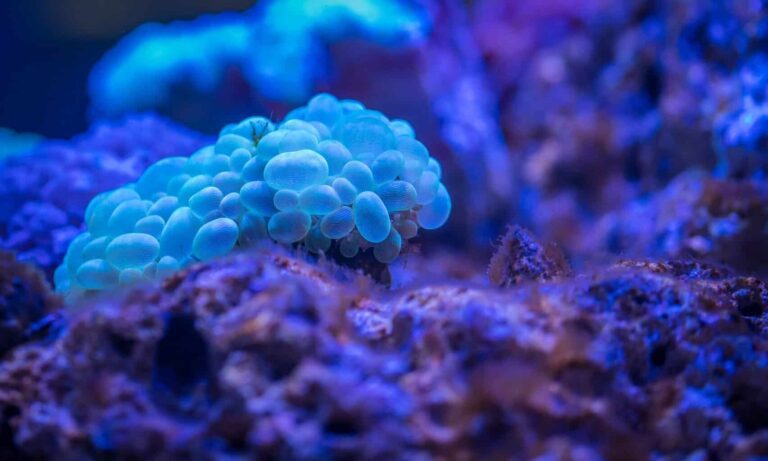Live aquarium plants are not only decorative, but they also help in keeping the water oxygenated and get rid of fish waste. However, not every type of aquarium plant is suitable. Some are only suitable for freshwater aquariums, while others are for salty aquariums. Similarly, if you have a 5-10 gallons fish tank, go for small plants for your aquarium.
Below are 8 small plants for aquariums that stay small forever.
1. Anubias Nana Petite
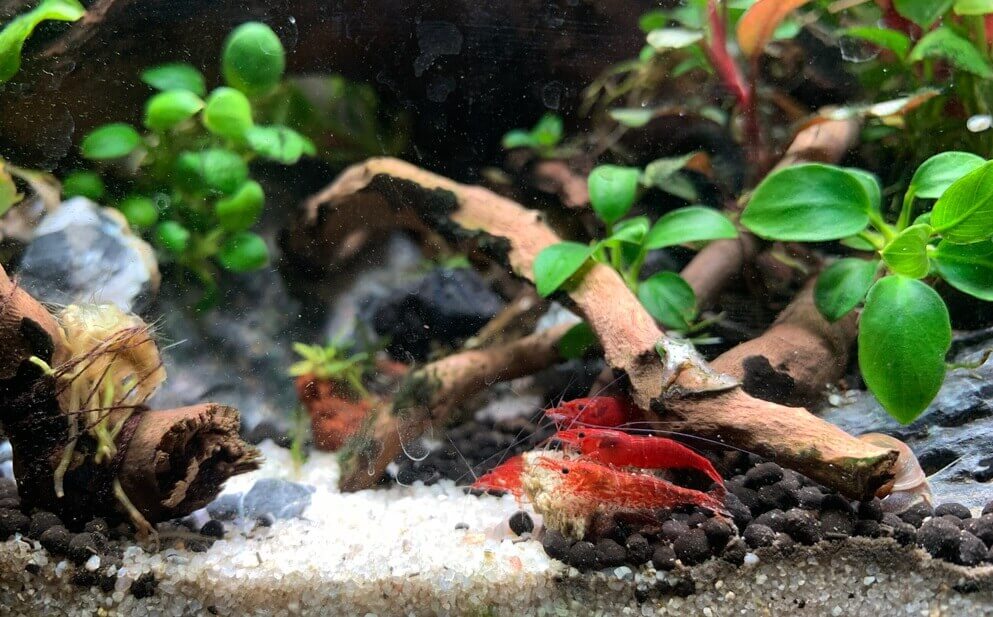
Anubias nana petite is one of the most commonly grown small plants for aquariums. It belongs to the Araceae family. Although there are a variety of Anubias plants, the Anubias Nana Petite is one of the smallest types.
It is a flowering plant with small, round, deep green leaves. The leaves are densely packed and grow to a maximum width of 1cm. It is a hardy plant that grows to a maximum height of 3-5inches.
When planting it, the roots should not be buried in the substrate. Instead, attach them to a rock or driftwood using super glue or a string. As it grows, its rhizomes spread, filling the tank space. The rhizomes can grow up to 10cm.
It is fairly easy to grow and maintain as it is a low-light aquarium plant. However, it can still thrive in high levels of light. It does not require CO2 but needs small amounts of fertilizers for nourishing. Trim older leaves to allow new ones to grow.
Anubias nana petite is prone to black rush and green spot algae. To get rid of the algae, remove the plant from the aquarium and soak it in one part of bleach and 20 parts of water. Leave it in the solution for a few hours until the algae whiten. Rinse it off with fresh water as you gently scrub the leaves. Then, put it back in the aquarium and reattach it to rocks or driftwood.
Although it grows slowly, it can withstand variations in water parameters. It is suitable as a foreground or mid-ground aquarium plant. It is a great option for small and nano fish aquariums.
2. Java Moss

Java moss is another great option for a planted tank. There are wide varieties of moss that you can try out for your aquascape, but java moss is the most popular. It is beautiful and functional. It provides shelter for shrimps and smaller fish and serves as a fry nursery. It also provides a carpet on the substrate and helps detoxify the water.
The aquatic plant has elongated, oval-shaped leaves that are bright in color. It thrives in fish tank temperatures between 70 and 75F but can also do well in higher temperatures, up to 90F. It thrives in low to high lighting conditions. It grows to a maximum height of 10 inches and is 4 inches wide.
It is easy to propagate, grow, and maintain. It is a suitable aquarium plant, but fish such as goldfish and cichlids tend to nib on it. The recommended minimum tank size is 5 gallons. It is compatible with both freshwater and brackish tanks. The java moss is suitable as a foreground plant.
To plant it, attach it to driftwood using a string, fish line, super glue, or elastic band. Allow two to four weeks for the roots to grow and take hold of the substrate, and then you can cut off the attachment. It is also suitable as a floating plant. Alternatively, you leave the plant to float freely in the water. It has a slow to moderate growth rate.
3. Java Fern
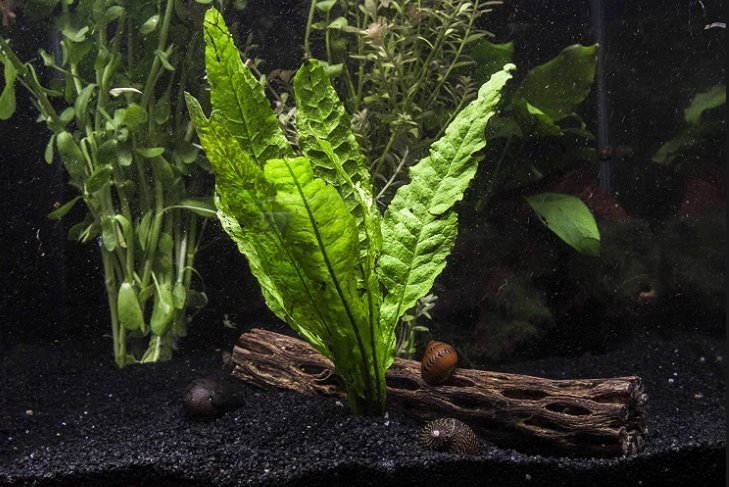
Java fern is most suitable for 10-gallon tanks and above. It can thrive whether partially or fully submerged in water. However, the rhizome and roots must remain submerged in water to prevent the plant from drying and dying, but the leaves can stick out.
It grows up to 10 inches tall and provides hiding spaces for fish. It has creeping, green rhizomes and a unique hair-like leaf structure. The color of the leaves can range from light to dark green, depending on the lighting conditions. The leaves are darker in higher amounts of light as the plant produces more chlorophyll.
It can survive in a wide range of water parameters ranging from low to high lighting conditions and soft acidic water to alkaline conditions. It can also grow in brackish water. It can be grown alongside banana lilies and Anubias Nana Petite. It is a great option for a betta fish aquarium.
4. Marimo Moss Ball
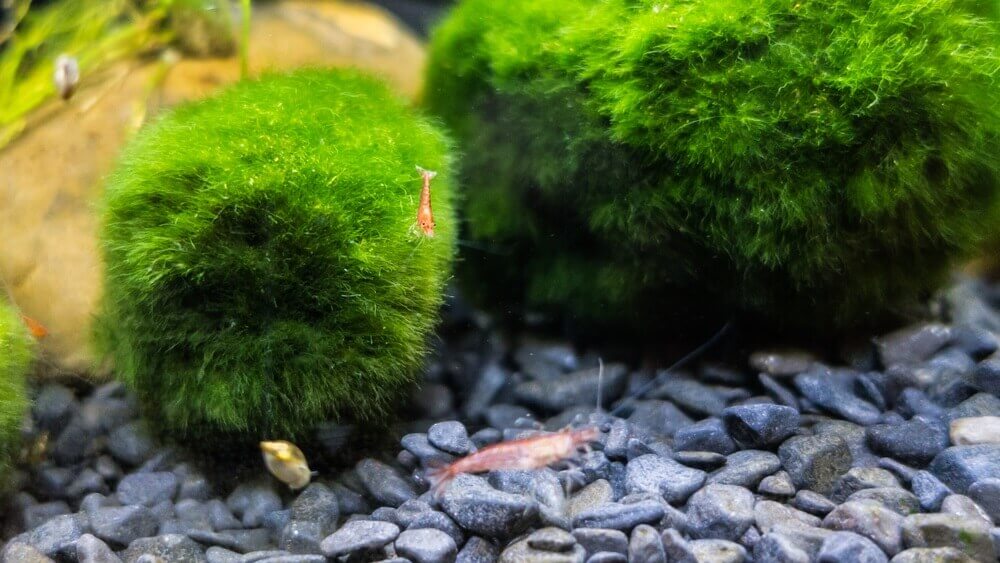
Marimo moss balls, also known as moss balls, or seaweed balls, are a unique type of algae that originated in Japan and Iceland. They are protected in their natural habitat as they are endangered plant species. They are also great for a betta fish aquarium.
They have a unique, perfectly round shape and grow slowly—at a rate of 5mm per year. They have a lifespan of 8-15 years. Most grow to a maximum width of 1.75-2.25 inches in diameter. However, they can grow as large as 3-4 inches in diameter. If you want to grow nano moss balls, cut the ball into smaller pieces and let them propagate in the aquarium. They will grow into separate nano balls.
Moss balls are easy to grow and require minimal maintenance. They do not require air and can survive in an airtight fish tank. They particularly thrive in brackish water and cooler temperatures no higher than 76F. However, they do just fine, even in low to moderate lighting.
If the water temperature is too high, they form brown spots. If you notice brown spots, take them out of the hot water, put them in a cold water-filled container, and then place them away in a refrigerator for 24 hours.
Although they make great tank mates for most freshwater fish, goldfish, large-sized crayfish, and some plecos tend to eat and damage them.
5. Monte Carlo

The Monte Carlo plant is also known as micranthemum. It is a relatively new aquarium plant species that originates from Argentina. It is a carpeting plant that grows well even in low lighting conditions.
It is easy to grow and maintain as it is adaptable. However, it requires medium to high lighting and CO2 injection for best results. Also, use a nutrient-rich substrate in your fish tank.
To plant it in your aquarium, attach it to a rock or driftwood. You may also insert the roots into the substrate. It will soon grow runners that spread out rapidly, providing a carpet on the substrate. It is best used as a foreground plant.
Once it is well established, it will require regular trimming. If left unattended, the carpet becomes too thick and tends to lift and float, causing the underlayers to suffocate and die off. Therefore, use a pair of landscaping scissors to cut off and discard the floating parts of the plant.
6. Dwarf Hairgrass
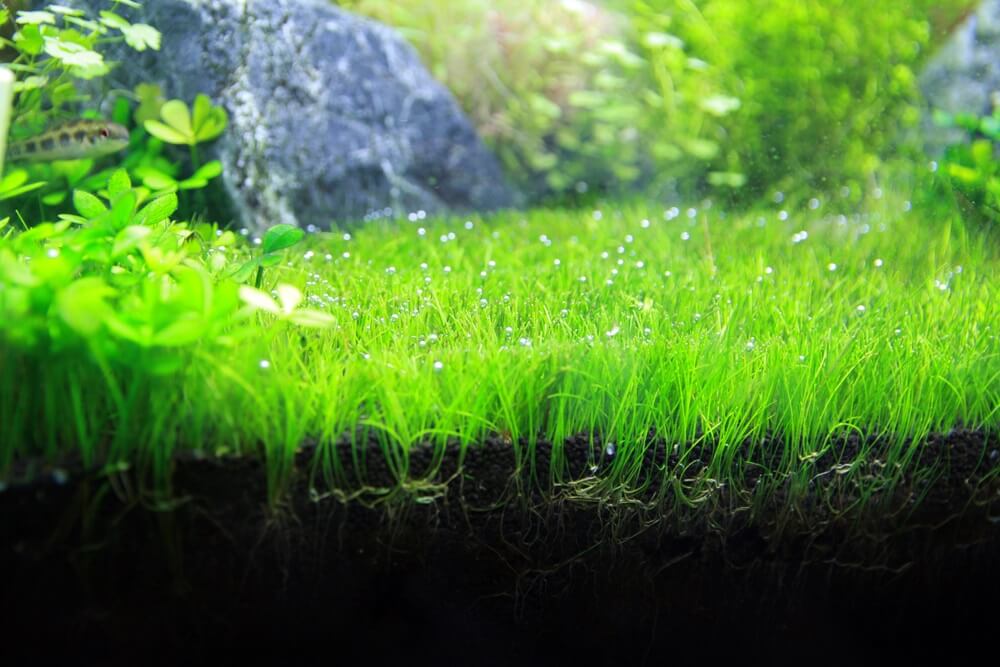
Dwarf hairgrass is commonly used as a carpeting foreground plant. The short, bright green grass grows 4-6 inches high. Like other runners, it has thin stalks and roots that grow horizontally. It is easy to grow whether you are a beginner, intermediate, or seasoned aquarium keeper.
The grass provides shelter for bottom dwellers, oxygenates, and removes nitrates from the water. It is a hardy and highly adaptable aquatic plant. Although CO2 injection is not required, it is necessary. It thrives in low to moderate light settings. The recommended minimum tank size to grow is 10 gallons.
7. Microsword
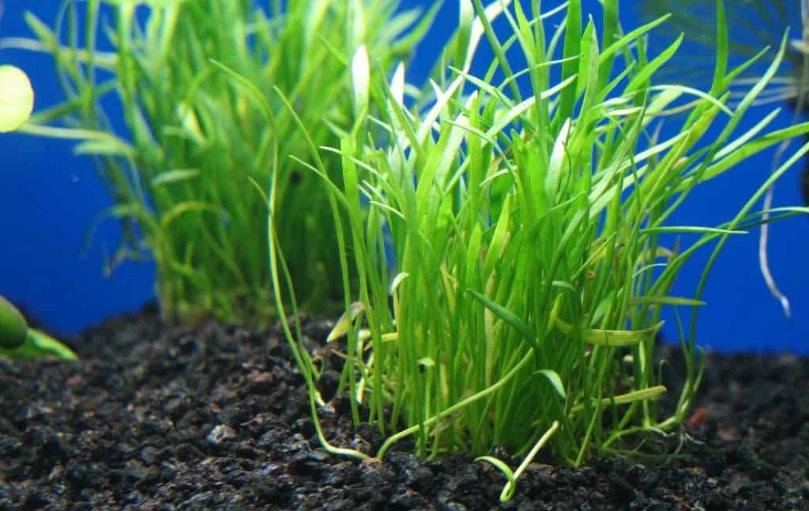
Microsword is a carpet grass suitable for freshwater aquariums. Also known as microsword grass, Brazilian micro sword, or copragrass, it is an easy-to-grow foreground grass-like carpet. It grows to a maximum height of 3 inches and thrives in medium to high light conditions. It has a slow growth rate. Fertilizer is required to provide it with essential nutrients. The optimal tank size is 10 gallons or more.
You can readily buy the microsword grass at your local pet store. It is usually sold as a potted plant. When buying, examine the leaves to ensure that the plant is healthy. Avoid a plant that has torn, yellow, cracked, or damaged leaves.
Handle the roots delicately when transplanting them from the pot to the aquarium. Separate the clumps into smaller parts that you plant in the substrate about ¼- ½ inch down. If it gets uprooted and floats in the water, replant it until it is well established. Once it is well-established, it begins to reproduce, and the runners spread throughout the substrate forming a lawn-like coverage.
The main issue with the microsword is that it is susceptible to algae growth. However, there are several ways to combat algae buildup. First, ensure that it does not have algae when buying it for planting. Break the clump into smaller portions before planting. This ensures that algae do not have a foothold, as large clumps slow down water movement. You may also incorporate algae-eating fish in the tank, e.g., amano and sherry shrimps in the fish tank.
8. Cryptocoryne Parva
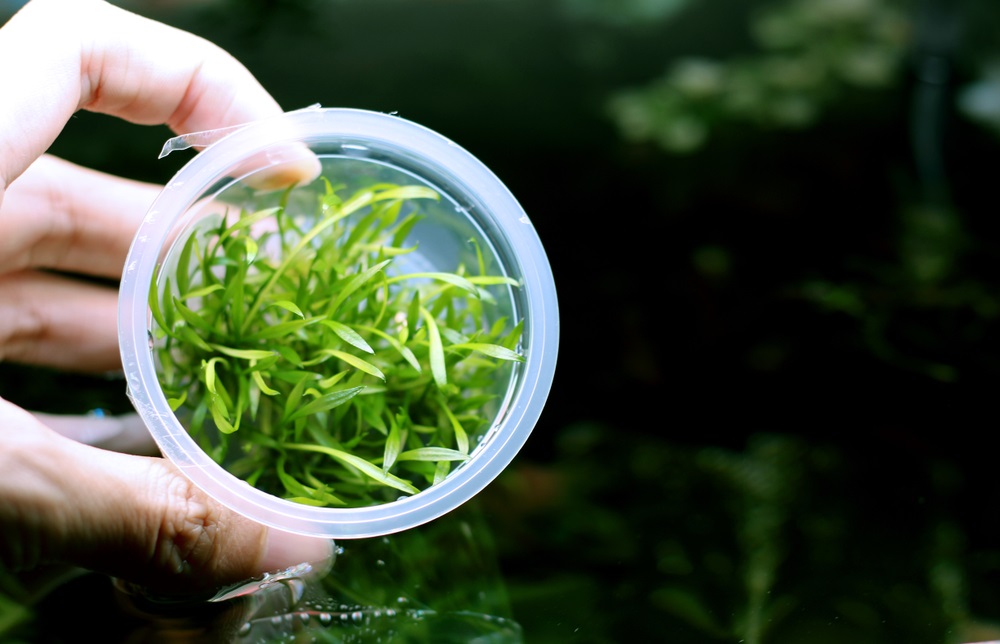
It is also known as parva crypt or the dwarf water trumpet; the cryptocoryne parv is a stem plant. Unlike other cryptocoryne varieties that grow quite tall, parva crypt is a short genus that grows to about 2-4 inches tall. The leaves spread about 2-3 inches wide, providing cover for fish. It is a great option for nano aquariums.
Also, unlike the other cryptocoryne genus that are low light plants, parva crypt thrives in moderate to high light conditions. Otherwise, it tends to grow upwards in search of light.
It is suitable as a foreground plant in your aquarium and does well in most water conditions but prefers warm and humid conditions. It can grow in a tank as small as 5 gallons. Although not required, it can benefit from fertilizers and carbon dioxide.
Like other crypts, the parva crypt becomes mushy when put in the aquarium. Do not remove it yet. It is not dead. The plant should revive after a few days. Crypts usually shed their leaves and develop new ones better adapted for breathing in water.
Conclusion
There is a variety of small plants for aquariums that remain small forever. Some are floating plants, others are stem plants, and others are grass-like carpet plants. They include java moss, anubius nana, marimo boss ball, and micro sword.
While some have specific ideal water parameters, others are quite adaptable. Research the various plants for a small aquarium to establish which ones would be best suited for your fish tank depending on their size, type of fish, and ideal water parameters.






